List of International (brand) trucks
| Auto Buggy/Auto Wagon | |
|---|---|
 Auto Wagon | |
| Production history | |
| Years built | 1907-1916 |
| Total built | 19,000+ |
| Drivetrain | |
| Engines |
Opposed 2-cylinder gasoline Air or water-cooled avail. |
| Power | 20 hp (15 kW) |
| Transmission | 2 speed |
| Chassis | |
| Tires | Solid rubber |
| Brakes |
External band drum (rear wheels only) |
| Drive layout | 4x2 |
| F series (1913) | |
|---|---|
|
1916 Model G | |
| Production history | |
| Years built | 1913-1923 |
| Total built |
29,000+ (all "Renault hood" types) |
| Weights | |
| Load rating | 3⁄4 to 3 1⁄2-ton (680-3175kg)[lower-alpha 1] |
| Drivetrain | |
| Engine | Inline 4 cyl. |
| Power | 30 hp (22 kW) |
| Transmission | 4-speed |
| Chassis | |
| Tires |
Solid rubber pneumanic avail. |
| Brakes |
External bands (rear wheels only) |
| Drive layout | 4x2 |
| S series (1921) | |
|---|---|
.jpg) 1922 "Red Baby" dealer's truck | |
| Production history | |
| Years built | 1921-1924 |
| Variants | Bus cowl-chassis |
| Weights | |
| Load rating | 1 to 5-ton-ton (905-4535kg)[lower-alpha 1] |
| Drivetrain | |
| Engine | Inline 4 cyl. |
| Power | 20 hp (15 kW) |
| Transmissions | 3-speed, 10-speed x 2 range |
| Chassis | |
| Brakes |
External bands (rear wheels only) |
| Drive layout | 4x2 |
| A Series (1930) | |
|---|---|
_(6979961856).jpg) 1931 A-2 | |
| Production history | |
| Years built | 1930-1934 |
| Weights | |
| Load rating[lower-alpha 1] | 3⁄4, 1 1⁄2, 2, 3, 5, and 7 1⁄2-ton (680-6800kg) |
| Drivetrain | |
| Engine | Inline 4, 6-cylinder |
| Power | 39 to 140 hp (29 to 104 kW) |
| Transmissions | 4, 5-speed |
| Chassis | |
| Brakes | Hyd., vacuum/hyd. |
| C Series (1934) | |
|---|---|
.jpg) 1935 C 1 | |
| Production history | |
| Years built | 1934-1936 |
| Variants | COE[lower-alpha 2] |
| Weights | |
| Load rating[lower-alpha 1] | 1⁄2 to 4 1⁄2-ton (454 to 4082kg) |
| Drivetrain | |
| Engines | Inline 4, 6 cyl. |
| Power | 78 to 90 hp (58 to 67 kW) |
| Transmissions | 4, 5-speed |
| Transmission (auxiliary) | 3-speed avail. |
| Chassis | |
| Rear axle | 2-speed avail. |
| Rear axles | Tandem, drive/tag avail. |
| Brakes | Mechanical drum |
| Drive layout | 4x2, 6x2, 6x4 |
| Metro (1938) | |
|---|---|
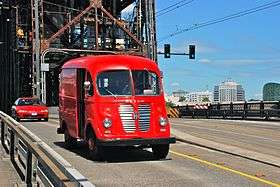 1958 (S chassis) | |
| Production history | |
| Years built | 1938-1963 |
| Plant built | Metro. Body Co. |
| Total built | 134,000+[lower-alpha 3] |
| Type | Step-van |
| Weights | |
| Load rating[lower-alpha 1] | 1⁄2 to 1 1⁄2-ton (450-1360kg) |
| Powertrain | |
| Engine | Inline 6-cyl. |
| Power | 113 to 140 hp (84 to 104 kW) |
| Transmissions | 3, 4-speed, 3-speed auto. |
| Chassis | |
| Rear axle | 2-speed avail. |
| Brakes | Hydraulic |
| K Series (1940) | |
|---|---|
 KB-5 (left) and KB-3 | |
| Production history | |
| Also sold as | KB Series (1947) |
| Years built | 1940-1949 |
| Total built | 650,000+ |
| Weights | |
| Load rating[lower-alpha 1][lower-alpha 4] | 1⁄2, 3⁄4, and 1-ton (450-900kg) |
| GVWR[lower-alpha 5] | 17,000 to 28,500 lb (7,700 to 12,900 kg) |
| Drivetrain | |
| Gasoline engines | International |
| Diesel engines | Cummins |
| Power | 64 to 225 hp (48 to 168 kW) |
| Transmissions | 3, 4, 5-speed |
| Transmission (auxiliary) | 3-speed avail. |
| Chassis | |
| Rear axle | 2-speed avail. |
| Brakes | Hydraulic |
| W series (1946) | |
|---|---|
| Production history | |
| Also sold as | West Coast |
| Years built | 1946-1948 |
| Plant built | Emeryville, CA |
| Weights | |
| GVWR[lower-alpha 5] | 30,000 lb (14,000 kg) |
| GCWR[lower-alpha 6] | 65,000 lb (29,000 kg) |
| Drivetrain | |
| Gasoline engines |
Continental Hall-Scott |
| Diesel engines | Cummins |
| Power | 150 to 275 hp (112 to 205 kW) |
| Transmissions | 4, 5-speed |
| Transmission (auxiliary) | 3-speed avail. |
| Chassis | |
| Rear axle | 2-speed avail. |
| Rear axles | 2-spd. tandem avail. |
| Brakes | Air |
| Drive layout[lower-alpha 7] | 4x2, 6x4 |
| L Series (1949) | |
|---|---|
 L-110 | |
| Production history | |
| Years built | 1949-1952 |
| Variants | COE[lower-alpha 8] |
| Weights | |
| Load rating[lower-alpha 1][lower-alpha 4] | 1⁄2, 3⁄4, 1, 1 1⁄2-ton (450-1360kg) |
| GVWR[lower-alpha 5] | 14,000 to 45,000 lb (6,400 to 20,400 kg) |
| GCWR[lower-alpha 6] | Up to 76,800 lb (34,800 kg) |
| Driveline | |
| Gasoline engines | International |
| Diesel engines | Cummins |
| Power | 100 to 300 hp (75 to 224 kW) |
| Transmissions | 3, 5-speed |
| Transmission (auxiliary) | 3-speed avail. |
| Chassis | |
| Rear axle | 2 speed avail |
| Rear axles | Tandem avail. |
| Brakes | Hyd., vac/hyd., air |
| Drive layout | 4x2, 6x4 |
| R Series (1953) | |
|---|---|
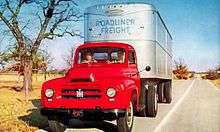 1953 R-165 | |
| Production history | |
| Years built |
1953-1960 (HD) 1953–1955 (LD) |
| Variants | COE[lower-alpha 8] |
| Weights | |
| Load rating[lower-alpha 1][lower-alpha 4] | 1⁄2, 3⁄4, 1, 1 1⁄2-ton (450-1360kg) |
| GVWR[lower-alpha 5] | 11,000 to 45,000 lb (5,000 to 20,400 kg) |
| GCWR[lower-alpha 6] | Up to 65,000 lb (29,000 kg) |
| Drivetrain | |
| Gasoline engines | International |
| Diesel engines | Buda, Cummins |
| LPG engine | Hall-Scott |
| Power | 100 to 356 hp (75 to 265 kW) |
| Transmissions | 3, 5, 10-speed |
| Transmission (auxiliary) | 3-speed avail. |
| Chassis | |
| Rear axle | 2-speed avail. |
| Rear axles | Tandem avail. |
| Brakes | Hyd., vac/hyd., air |
| Drive layout | 4x2, 6x4 |
| A and B series (1957) | |
|---|---|
 1959/1960 B-120 4x4 | |
| Production history | |
| Years built | 1957-1961 |
| Variants | Short hood (AC, BC) |
| Weights | |
| Load rating[lower-alpha 1][lower-alpha 4] | 1⁄2, 3⁄4, 1, 1 1⁄2-ton (450-1360kg) |
| GVWR[lower-alpha 5] | 16,000 to 43,000 lb (7,300 to 19,500 kg) |
| GCWR[lower-alpha 6] | Up to 50,000 lb (23,000 kg) |
| Drivetrain | |
| Engines | Gasoline I6, V8 |
| Power | 140 to 154 hp (104 to 115 kW) |
| Transmissions | 4, 5, 7-speed |
| Transfer case | 2-speed with front drive |
| Chassis | |
| Front axle | Driven avail. |
| Rear axle | 2-speed avail. |
| Rear axles | Tandem avail. |
| Brakes | Hyd., vacuum/hyd., air |
| Drive layout | 4x2, 4x4, 6x4, 6x6 |
| Loadstar (1962) | |
|---|---|
.jpg) 4x2 dump truck | |
| Production history | |
| Years built | 1962-1976 |
| Total built | 940,000+ |
| Variants | CO,[lower-alpha 2] Crew-cab, Schoolmaster |
| successor | S series |
| Weights | |
| GVWR[lower-alpha 5] | 18,200 to 30,200 lb (8,300 to 13,700 kg) |
| GCWR[lower-alpha 6] | Up to 50,000 lb (23,000 kg) |
| Drivetrain | |
| Engines | Gasoline V8s |
| Power | 112 to 210 hp (84 to 157 kW) |
| Transmissions | 4 and 5-speed |
| Transfer case | 2-speed with front drive |
| Chassis | |
| Front axle | Driven avail. |
| Rear axle | 2 speed available |
| Rear axles | Tandem avail. |
| Brakes | Vac/hyd., air/hyd., air |
| Drive layout[lower-alpha 7] | 4x2, 4x4, 6x4, 6x6 |
| Fleetstar (1963) | |
|---|---|
| Production history | |
| Years built | 1963-1976 |
| Variants | Steel or fiberglass hood |
| successor | S series |
| Weights | |
| GVWR[lower-alpha 5] | 37,500 to 61,000 lb (17,000 to 27,700 kg) |
| GCWR[lower-alpha 6] | Up to 79,000 lb (36,000 kg) |
| Drivetrain | |
| Gasoline engines | International |
| Diesel engines | Caterpillar, Cummins, Detroit Diesel, Int'l. |
| Power | 180 to 335 hp (134 to 250 kW) |
| Transmissions | 5, 6, 7, 10, 13-speed |
| Chassis | |
| Rear axles | Tandem avail. |
| Brakes | Air |
| Drive layout[lower-alpha 7] | 4x2, 6x4 |
| Transtar CO 4070 (1968) | |
|---|---|
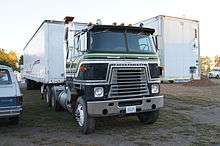 CO 4070B | |
| Production history | |
| Years built | 1968-1983 |
| Type | Cab-over-engine (COE)[lower-alpha 9] |
| Variants | Day cab, sleeper |
| predecessor | CO4000D |
| successor | CO9670 |
| Weights | |
| GVWR[lower-alpha 5] | 35,000 to 49,500 lb (15,900 to 22,500 kg) |
| GCWR[lower-alpha 6] | Up to 80,000 lb (36,000 kg) |
| Drivetrain | |
| Engines | Caterpillar, Cummins, Detroit Diesel |
| Power | 230 to 434 hp (172 to 324 kW) |
| Transmissions | 9, 10, 13, 14-speed |
| Chassis | |
| Brakes | Air |
| Drive layout[lower-alpha 7] | 4x2, 6x4 |
| Transtar 4200/4300 (1970) | |
|---|---|
| Production history | |
| Also sold as | 9000 after 1984 |
| Years built | 1970-1999 |
| Type | Conventional |
| Variants | Conventional |
| Weights | |
| GVWR[lower-alpha 5] | 35,000 to 54,000 lb (16,000 to 24,000 kg) |
| GCWR[lower-alpha 6] | Up to 120,000 lb (54,000 kg) |
| Drivetrain | |
| Engines | Cummins, Detroit Diesel |
| Power | 230 to 434 hp (172 to 324 kW) |
| Transmissions | 9, 10, 13, 14-speed |
| Chassis | |
| Brakes | Air |
| Drive layout[lower-alpha 7] | 4x2, 6x4 |
| Cargostar (1972) | |
|---|---|
|
| |
| Production history | |
| Years built | 1972-1980 |
| predecessor | Loadstar CO |
| Weights | |
| GVWR[lower-alpha 5] | 19,500 to 54,000 lb (8,800 to 24,500 kg) |
| GCWR[lower-alpha 6] | Up to 65,000 lb (29,000 kg) |
| Drivetrain | |
| Gasoline engines | International V8s |
| Diesel engines |
Caterpillar, Detroit Diesel International |
| Power | 170 to 227 hp (127 to 169 kW) |
| Transmissions |
4, 5, 10, 13-speed 4, 5, 6-speed auto. |
| Chassis | |
| Rear axle | 2-speed avail. |
| Rear axles | Tandem avail. |
| Brakes | Vacuum/hyd., air |
| Drive layout[lower-alpha 7] | 4x2, 6x4 |
| Paystar (1972-1999) | |
|---|---|
 Paystar 5000 with driven front axle | |
| Production history | |
| Years built | 1973-1999 |
| Variants | SBA, SFA, FWD, steel or fiberglass hood |
| Weights | |
| GVWR[lower-alpha 5] | 48,860 to 73,160 lb (22,160 to 33,180 kg) |
| GCWR[lower-alpha 6] | Up to 120,000 lb (54,000 kg) |
| Drovetrain | |
| Engines |
Caterpillar, Cummins Detroit Diesel, Int'l |
| Power | 190 to 350 hp (140 to 260 kW) |
| Transmissions | 5, 6, 7, 8, 13, 18-spd. |
| Transmissions (auxiliary) | 3, 4-speed |
| Transfer case | 2-speed with driven front axle |
| Chassis | |
| Front axle | Driven avail. |
| Brakes | Air |
| Drive layout[lower-alpha 7] | 6x4, 6x6 |
| S Series (1977) | |
|---|---|
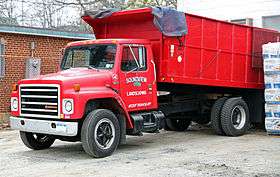 | |
| Production history | |
| Also sold as | 2000 Series after 1988 |
| Years built |
1977-1988 (1600-2200) 1977-2001 (2500, 2600) |
| Plant built | Springfield, OH |
| Variants | Crew-cab, Schoolmaster |
| predecessor | Loadstar, Fleetstar |
| successor | 4000 series |
| Weights | |
| GVWR[lower-alpha 5] | 19,500 to 54,000 lb (8,800 to 24,500 kg) |
| GCWR[lower-alpha 6] | Up to 65,000 lb (29,000 kg) |
| Drivetrain | |
| Gasoline engines | International V8s |
| Diesel engines |
Caterpillar, Cummins Detroit Diesel |
| Power | 170 to 227 hp (127 to 169 kW) |
| Transmissions |
4 to 10, 13-speed 4, 5-speed auto. |
| Transfer case | 2-speed with front drive |
| Chassis | |
| Front axle | Driven avail. |
| Rear axle | 2-speed avail. |
| Rear axles | Tandem avail. |
| Brakes | Vacuum/hyd., air |
| Drive layout[lower-alpha 7] | 4x2, 4x4, 6x4, 6x6 |
| 8000 Series (1987) | |
|---|---|
.jpg) 8200 with long hood | |
| Production history | |
| Years built | 1987-2001 |
| Variants | Long and short hood models |
| Weights | |
| GCWR[lower-alpha 6] | Up to 110,000 lb (50,000 kg) |
| Drivetrain | |
| Engines | Caterpillar, Cummins |
| Power | 240 to 350 hp (180 to 260 kW) |
| Transmissions | 7, 9, 13, 15-speed and others |
| Chassis | |
| Brakes | Air |
| Drive layout[lower-alpha 7] | 4x2, 6x4 |
| 4000 Series (1988) | |
|---|---|
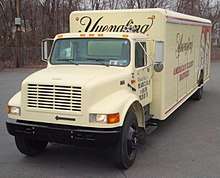 4900 | |
| Production history | |
| Years built | 1988-2001 |
| Variants | Crew-cab, Low-profile |
| predecessor | S Series |
| successor | 4000 NGV |
| Weights | |
| GVWR[lower-alpha 5] | 21,500 to 35,000 lb (9,800 to 15,900 kg) |
| Drivetrain | |
| Engines | Navistar |
| Power | 170 to 270 hp (130 to 200 kW) |
| Transmissions |
5-8, 10, 13-speed 5-speed auto. |
| Transfer case | 2-speed with front drive |
| Chassis | |
| Front axle | Driven avail. |
| Brakes | Air |
| Drive layout[lower-alpha 7] | 4x2, 4x4, 6x4 |
| 4400 / DuraStar (2001) | |
|---|---|
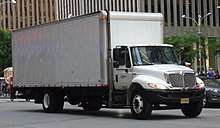 2014 4400 | |
| Production history | |
| Years built | 2001-2017 |
| Variants | Crew-cab |
| Weights | |
| GVWR[lower-alpha 5] | 23,500 to 44,600 lb (10,700 to 20,200 kg) |
| Drivetrain | |
| Engines | Cummins, International |
| Power | 200 to 350 hp (150 to 260 kW) |
| Transmissions |
6, 7, 10-speed 6-speed auto |
| Chassis | |
| Brakes | Air |
| Drive layout[lower-alpha 7] | 4x2, 6x4 |
| 5000i / PayStar (2000) | |
|---|---|
|
2009 PayStar 5000 | |
| Production history | |
| Years built | 2000-2016 |
| Weights | |
| GVWR[lower-alpha 5] | 35,000 to 80,000 lb (16,000 to 36,000 kg) |
| Drivetrain | |
| Engines | Caterpillar, Cummins, International |
| Power | 260 to 475 hp (194 to 354 kW) |
| Transmissions |
10, 11, 13, 18-speed 6-speed auto. |
| Transfer case | 2-speed with front drive |
| Chassis | |
| Front axle | Driven avail. |
| Rear axles | Tandem, tridem avail. |
| Brakes | Air |
| Drive layout[lower-alpha 7] | 4x2, 4x4, 6x4, 6x6, 8x6 |
| 7000 / WorkStar (2001) | |
|---|---|
|
2012 7600 | |
| Production history | |
| Years built | 2001-2016 |
| Weights | |
| GVWR[lower-alpha 5] | 27,500 to 73,000 lb (12,500 to 33,100 kg) |
| GCWR[lower-alpha 6] | Up to 140,000 lb (64,000 kg) |
| Drivetrain | |
| Engines | Cummins, International |
| Power | 260 to 475 hp (194 to 354 kW) |
| Transmissions |
6,8,9,10,11,13,15,18-speed 6-speed auto. |
| Transfer case | 2-speed with front drive |
| Chassis | |
| Front axle | Driven avail. |
| Rear axles | Tandem, tridem avail. |
| Brakes | Air |
| Drive layout[lower-alpha 7] | 4x2, 4x4, 6x4, 6x6, 8x6 |
| 8000 / TranStar (2002) | |
|---|---|
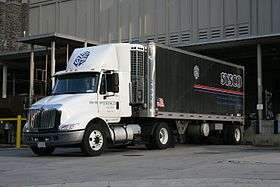 8600 | |
| Production history | |
| Years built | 2002-2016 |
| Variants | Extended cab, fairings |
| Weights | |
| GVWR[lower-alpha 5] |
27,500 lb (12,500 kg) to 60,000 lb (27,000 kg) |
| Drivetrain | |
| Engines | Caterpillar, Cummins, International |
| Power | up to 475 hp (354 kW) |
| Transmissions | 10-speed |
| Chassis | |
| Rear axles | Single, tandem |
| Drive layout[lower-alpha 7] | 4x2, 6x2, 6x4 |
| 9000i (2000-2016) | |
|---|---|
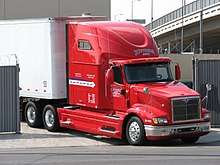 9400i | |
| Production history | |
| Years built | 2001-2016 |
| Variants | Sleepers |
| Weights | |
| GVWR[lower-alpha 5] |
52,000 lb (24,000 kg) to 60,000 lb (27,000 kg) |
| Drivetrain | |
| Engines | Caterpillar, Cummins |
| Power | up to 600 hp (450 kW) |
| Transmissions | 10-speed |
| Chassis | |
| Rear axles | Tandem |
| Drive layout[lower-alpha 7] | 6x4 |
| ProStar (2006) | |
|---|---|
|
| |
| Production history | |
| Years built | 2006-2016 |
| Weights | |
| GVWR[lower-alpha 5] | 27,500 to 73,000 lb (12,500 to 33,100 kg) |
| GCWR[lower-alpha 6] | Up to 140,000 lb (64,000 kg) |
| Drivetrain | |
| Engines | Cummins, Navistar |
| Power | 370 to 550 hp (280 to 410 kW) |
| Transmissions | Eaton, Allison, Tremec |
| Chassis | |
| Brakes | Air |
| Drive layout[lower-alpha 7] | 4x2, 6x2, 6x4 |
| HX Series (2016) | |
|---|---|
| Production history | |
| Years built | 2016- |
| Weights | |
| GVWR[lower-alpha 5] | 52,000 to 92,000 lb (24,000 to 42,000 kg) |
| Drivetrain | |
| Engines | Cummins, Navistar |
| Power | 370 to 600 hp (280 to 450 kW) |
| Transmissions | Eaton, Allison |
| Chassis | |
| Rear axles | Tandem, tridem avail. |
| Brakes | Air |
| Drive layout[lower-alpha 7] | 6x4, 8x6 |
| HV Series (2017) | |
|---|---|
| Production history | |
| Years built | 2017- |
| Weights | |
| GVWR[lower-alpha 5] | 53,000 to 73,000 lb (24,000 to 33,000 kg) |
| Drivetrain | |
| Engines | Cummins |
| Transmissions | Eaton, Allison |
| Transfer case | 2-speed with front drive |
| Chassis | |
| Front axle | Driven avail. |
| Rear axle | 2-speed avail. |
| Rear axles | Tandem, tridem avail. |
| Brakes | Air |
| Drive layout[lower-alpha 7] | 4x2, 4x4, 6x4, 6x6, 8x6 |
| LT Series (2017) | |
|---|---|
| Production history | |
| Years built | 2017- |
| Weights | |
| GVWR[lower-alpha 5] | 32,000 to 60,000 lb (15,000 to 27,000 kg) |
| Drivetrain | |
| Engines | Cummins, International |
| Power | 260 to 475 hp (194 to 354 kW) |
| Transmissions | Eaton |
| Chassis | |
| Brakes | Air |
| Drive layout[lower-alpha 7] | 4x2, 6x2, 6x4 |
| RH Series (2017) | |
|---|---|
| Production history | |
| Years built | 2017- |
| Weights | |
| GVWR[lower-alpha 5] | 32,000 to 60,000 lb (15,000 to 27,000 kg) |
| Drivetrain | |
| Engine | International A26 |
| Power | 370 to 450 hp (280 to 340 kW) |
| Transmissions | Eaton |
| Chassis | |
| Brakes | Air |
| Drive layout[lower-alpha 7] | 4x2, 6x2, 6x4 |
| MV Series (2018) | |
|---|---|
| Production history | |
| Years built | 2018- |
| Variants | Low profile |
| Weights | |
| GVWR[lower-alpha 5] | 21,500 to 54,600 lb (9,800 to 24,800 kg) |
| Drivetrain | |
| Engine | Cummins B6.7, L9 |
| Power | 200 to 450 hp (150 to 340 kW) |
| Transmissions |
Eaton Fuller manual, automated manual, automatic Allison automatic |
| Chassis | |
| Brakes | Hydraulic disc, Air |
| Drive layout[lower-alpha 7] | 4x2, 6x4 |
International trucks have been built and sold by the International Harvester Company (renamed Navistar International in 1986) from 1914 until the present (2018). Before 1914 trucks were sold as "International", "International Harvester", and "International Motor Trucks".
Originally marketed to farmers the trucks were immediately successful and were sold to businesses in cities as well. Since then International trucks have been sold worldwide and built or assembled in the United States, Australia, Brazil, Canada, England, Germany, Mexico, South Africa, the Soviet Union, and Turkey.
In 2018 International markets six separate series of medium-duty, heavy-duty, and severe-service trucks with loaded weights up to 92,000 pounds (42,000 kg) and up to 140,000 pounds (64,000 kg) including trailers. International also has always built a wide range of custom and speciality use trucks and chassis.
1902–1919
In 1902 five Chicago-based farm machinery companies merged to become International Harvester Company. The new company had dealers and plants throughout the mid-west.
In 1907 they released the Auto-Buggy, a small vehicle designed for rural roads and conditions. After building one hundred pre-production models in Chicago production began in Akron, Ohio. A second vehicle, the Auto Wagon with a cargo body, was introduced in 1909. Other than the engine itself they used the same technology as then current farm equipment. They could be understood and maintained by farmers and serviced by the dealer network already in place. In 1909 the two-seat Roadster was also introduced. An entirely different vehicle, this was the only passenger automobile International Harvester built.
The Auto Buggy and Auto Wagon were successful, over 3,000 had been built by 1910. At the time this was a very large number in a new market. Designed for farmers, city businesses were also buying them. In 1911 the Auto Wagon was offered in models with different sizes and bodies. Since then International has offered a wide range of models and chassis for specialized bodies.
In 1915 a new type of truck with a front-mounted engine and lower profile tires, the Model F series, was introduced to replace the crude Auto-Wagons.[1][2][3]
Auto Buggy (1907)
Models: Auto Buggy, Auto Wagon AA, AW, MA, MW, MAX, MWX[4]
The Auto Buggy was the first powered vehicle built by International Harvester. It was designed for farmers using poor rural roads. It was basically a light wooden buggy with a primitive gasoline engine mounted below the body. Tall wooden-spoke wheels had iron treads on a wooden rim. Later pneumatic tires could be fitted. They were sometimes called "Highwheelers". Seats could be mounted in the rear for two more passengers. The Auto Buggy was discontinued in 1912 as International focused on trucks.
The Auto Wagon was introduced in 1909. It was an Auto Buggy with a wagon body. In 1912 there were six models. They would be built until 1916.
Development started in 1898. A two-cylinder air-cooled engine developing 20 hp (15 kW) was mounted under the body. By 1912 a water-cooled version was available. A two-speed transmission used roller-chains to drive the rear wheels. There was a mechanical band brake for the rear wheels.
An un-related "High-wheeler", the Roadster, was offered from 1910 to 1912. It had a gasoline inline 4 with a three-speed transmission, driveshaft, and geared differential axle.[5][6][7]
F Series (1913)
Models: F, G, H, K, L[4]
The Model F was a completely different type of truck than the Auto Wagon. It had a steel ladder frame with beam axles on semi-elliptic leaf springs. A front-mounted, water-cooled engine drove through a four-speed transmission and driveshaft to a geared differential rear axle. There were external band brakes on the rear wheels
The F had a "Renault-type" tapered hood with the radiator behind the engine (the Mack AC "Bulldog" also had one). This was thought to protect the radiator and make the engine easier to work on. It put the hot radiator directly in front of the driver and it was hard to work on the radiator. This was the only series to have one.[8][9]
.jpg) 1910 Auto Buggy
1910 Auto Buggy_(14595401678).jpg) 1913 Auto Wagon
1913 Auto Wagon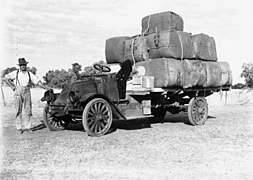 1916 F Series
1916 F Series
1920–1939
In the 1920s trucks developed a common layout. A water cooled engines with a front mounted radiator drove a transmission, driveshaft, and rear axle with a geared differential (only very heavy-duty trucks used chain-drive). Cabs became more enclosed.
In 1921 a factory in Springfield, Ohio, was modified for truck production. 1923 a new plant was opened in Fort Wayne, Indiana. It replaced the Akron plant for truck production. In 1922 International built its first school bus (on a S-Series). Cowl-chassis for school busses have been offered ever since.
In 1934 the C Series were the first International trucks with internal expanding drum brakes.
Also in 1934 Hendrickson walking-beam tandem rear axles were introduced in heavy trucks. They remain available in 2018.
In 1936 all International models were equipped with hydraulic service brakes. All following models would have either hydraulic or air service brakes.[10][11][12][13]
Metro (1938)
Models: D, K/KB, L, R, S, and A chassis[14]
The Metro series step vans were introduced in 1938. This vehicle type was once commonly used for milk or bakery delivery.[15] The overall design of the Metro vans remained largely unchanged from 1938 until 1965 when it was redesigned with a squared body.[16][17][18]
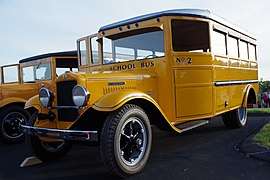 1932 School bus
1932 School bus 1933 A series
1933 A series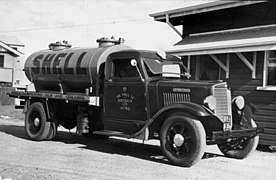 1934 C series
1934 C series
1940–1959
The K-series, introduced in 1940, was built in large numbers during World War II for civilians, the military, and Lend-Lease export. When the war was over it was slightly updated and sold until the new post-war designs were introduced in the 1950s.
In 1952 a panel truck fitted with windows was introduced as the Travelall. With rear seats installed it was a heavy station wagon and without seats it could carry cargo. The Travelall became a standard model in the light truck series.[19][20][21][22]
K and KB Series (1940-1948)
Models: (K) 1, 1-M, 2, 3, 3-M, 4, 5, 6, 7, 7-COE, 8, 11, 12[23]
Models: (KB) 1, 1-M, 2, 3, 3-M, 5, 6, 7, 8, 10, 11, 12[24]
The K Series was introduced in mid 1940. All models had the same cab but heavier versions had taller bodywork and different hoods for larger engines and stronger chassis. Inline six-cylinder gasoline engines were used. Three, four, and five speed transmissions were used. In 1947 the K was updated as the KB. All models had hydraulic drum brakes. The model K-8 and models KB-8 and larger were available with tandem rear axles. The KB series was replaced by the L Series in 1949.[25][26][27]
L Series (1949–1952)
Models: 110, 120, 130, 150, 160, 170, 180, 190, 200, 210, 300[28]
The L-Series was introduced in 1949. All models had the same cab but heavier versions had taller bodywork and different hoods for larger engines and stronger chassis. Inline six-cylinder gasoline engines were used. Three, four, and five speed transmissions were used. All models had all-wheel hydraulic drum brakes, the 160 and larger models had vacuum assist Air brakes were available on larger models. The 170, 190, and 210 models were available with tandem rear axles. The L-series was replaced by the R Series in 1952.[29][30][31]
R series (1953-1971)
Models: 110, 120, 130, 140, 150, 160, 170, 180, 190, 200, 220, 300, 310, 1700, 1800[32]
The R series replaced the L-Series in 1953. It was largely a facelift of the light and medium models, there were few mechanical changes. All models had the same cab but heavier versions had taller bodywork and different hoods for larger engines and stronger chassis. Inline six-cylinder gasoline engines were used, in models 190 and larger a Cummins diesel was available. Three, four, and five speed transmissions were used. All models had hydraulic drum brakes standard, the 160 and larger had vacuum assist. The 180 and larger models were available with air brakes. The 170 and larger models were available with tandem rear axles. In 1955 the new S Series was announced, replacing the light and medium-sized models. The heavier-duty versions were replaced in 1972.
A and B Series (1957)
Models: (A/B) 100, 110, 120, 130 140, 150, 160, 170, 180[33]
Models: (AC/BC) 150, 160, 170, 180, 1890[34]
The A-Series (or A-line) replaced the S-Series in April 1957. The name stood for "Anniversary", as 1957 marked the fiftieth (or Golden) anniversary of truck production. It was largely a re-bodied version of the light and medium S-Series truck, incorporating a wide cab and more integrated fenders.[35] A modified version of this truck range was also built in Australia until 1979, where it was marketed both as an International and as a Dodge. In 1959 a facelift and optional V8 engines changed the name to the B-Series.[36] A variant, the AC/BC, was a modified conventional with the cab mounted higher on the frame and a shorter hood. These model's layout and cab led directly to the Loadstar, which replaced them in 1962. At that time International stopped building long conventional medium-duty trucks.[37]
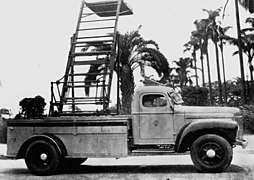 K Series
K Series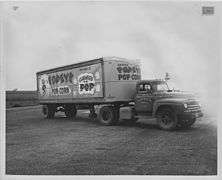 L-180
L-180.jpg) R-160
R-160
1960–1979
In the 1960s a range of new named series were introduced. The Loadstar, Fleetstar, and Transtar (Paystar was added in 1972) would be built without major change until replaced between 1977 and 2001.
In 1977 the S Series was introduced. They replaced the Loadstar and Fleetstar completely and could do some of the work of the Paystar and Transtar. They were so successful that they are sometimes considered the truck that saved International Harvester from bankruptcy. S Series (and improved "thousand" series) models were built until replaced between 2001 and 2003. [38][39][40][41]
Loadstar (1962–1979)
Models: 1600, 1600 4x4, 1700, 1700 4x4, F1700[lower-alpha 10], F1700 6x6, 1800, F1800, CO-1600[lower-alpha 2], CO-1700, CO-1800, and Schoolmaster chassis
The Loadstar was a medium-duty short-hood conventional introduced in 1962. When introduced it had a grey grill and "butterfly" hood, but in 1971 a one-piece tilting hood became standard. The cab (also used on the Fleetstar) had been introduced on the A series in 1957. Cab-over-engine models were also available until replaced by the Cargostar in 1971. The Loadstar was used for local delivery, construction, and farming. The 1800 was available as a semi-tractor. With all wheel drive it was also used for fire engines, snow-plows, and utility work. The Loadstar conventionals were replaced by the S Series in 1977.
The Loadstar had gasoline, mid-range diesel, and LPG engines. The short hood of the Loadstar meant that V-8 engines fit better than longer inline-6 engines, only the small "Blue Diamond BD264/282/308 with 154 to 202 horsepower (115 to 151 kW) were used. V8 gasoline engines were the V304/345/392 family with 136 to 178 horsepower (101 to 133 kW). LPG models were also available. In 1974 the larger block MV404 with 206 horsepower (154 kW) was introduced. Mid-range diesels were International V8s up to 200 horsepower (150 kW), the Detroit Diesel 6V53 with ???, and Perkins inline-6s up to 130 horsepower (97 kW).
The 1600 had a 4-speed manual synchromesh transmission standard, all other models had a 5-speed. standard. All gasoline single axle models could have a 2-speed rear axle. Some larger models were available with 8- and 10-speed Roadranger manual transmissions. 4- and 6-speed automatic transmissions were available on some models.[42]
All models had vacuum assisted hydraulic drum brakes standard. Air over hydraulic (where compressed air applies the hydraulic brakes) and full air brakes were available. A driven front axle was available on 1600 and 1700 models and tandem axles were available on 1700 and 1800 models (cab-over-engine models could have neither). Gross vehicle weight ratings (total weight of the truck) were from 18,200 to 30,200 pounds (8,300 to 13,700 kg) up to 30,200 pounds (13,700 kg) and up to 50,000 pounds (23,000 kg) including trailers.[43][44][45]
Fleetstar (1963–1977)
Models: 1900, F1900[lower-alpha 10], 2000, F2000, 2000D, F2000D, 2050, F2050, 2070, F2070, 2100, F2100
The Fleetstar was a heavy-duty short-hood conventional. It was introduced in 1962 and entered production in 1963. The cab, grey grill, and "butterfly" hood were the same as used on the Loadstar. In 1971 a one-piece tilting hood became standard. The Fleetstar was used as both a local straight truck with mid-range engines and as a semi-tractor with heavy-duty engines. The Fleetstar was replaced by the S-Series in 1977.
The Fleetstar had gasoline, mid-range diesel, and heavy-duty diesel engines. The short hood meant that the longer inline-6-cylinder engines continued back through the firewall and into the cab. A shroud ("doghouse") came back from the firewall and covered the engine to the floor. Gasoline engines were the "Red Diamond" RD-406/450/501 family of inline-6 engines with 175 to 202 horsepower (130 to 151 kW) and the VS-401/478/549 with 206 to 285 horsepower (154 to 213 kW). Mid-range diesels were the Cummins V6 with 195 horsepower (145 kW), International V8s with up to 180 horsepower (130 kW), the Caterpillar 3208 with 225 horsepower (168 kW), and the DT466 with 210 horsepower (160 kW). The heavy-duty diesels were Cummins from the NH220 with 220 horsepower (160 kW) to the NTC335 with 335 horsepower (250 kW), a Detroit Diesel 6-71 with 238 horsepower (177 kW), and a Caterpillar 3406 with 325 horsepower (242 kW).
All models except Detroit Diesels had a five speed transmission standard, the Detroit Diesel models had a 10-speed Roadranger. Single axle trucks with 5-speed transmissions had 2-speed rear axles available. Nine-, 10-, and 13-speed Roadrangers were available on heavier models.
All gasoline models had vacuum assisted hydraulic drum brakes standard. Air trailer brakes and full air brakes were available. Diesel models had full air brakes. Gross vehicle weight ratings (total weight of the truck) could be from 37,500 pounds (17,000 kg) up to 61,000 pounds (28,000 kg) and up to 79,000 pounds (36,000 kg) including trailers.[43][46][47]
Transtar CO4070 (1968–1981)
Models: CO4070A[lower-alpha 2], COF4070A[lower-alpha 10], CO4070B, COF4070B, COF4090A
The Transtar cab-over-engines models were heavy-duty over-the-road semi-tractors introduced in 1968. They used an improved CO4000 cab from 1965, The CO4090A and 4070B had the cab raised so high-power engines could be used. Daycab models were available for regional use but most had a 23 inches (58 cm) or 33 inches (84 cm) inch sleeper compartment. In 1974 the improved raised cab CO4070B Transtar II was introduced and the low-cab version was discontinued. The Transtar II was replaced by the CO9670 in 1984.
The CO4070/4090 had heavy duty and high-power diesel engines. Detroit Diesel had the 6-71 with 238, 8V-71 with 350 horsepower (260 kW), the 6V-92 with 270 horsepower (200 kW), and the 8V-92 with 445 horsepower (332 kW). Cummins had the NH230 with 230 horsepower (170 kW) to the KT450 with 450 horsepower (340 kW). A Caterpillar 3406 with 400 horsepower (300 kW) was available.
All models had a 10-speed Roadranger transmission standard, 9, 13, 15, and a Spicer 14-speed transmissions were optional.
All Transtars had full air brakes. Gross vehicle weight ratings (total weight of the truck) were from 35,000 to 49,500 pounds (15,900 to 22,500 kg) and up to 79,000 pounds (36,000 kg) including trailers..[43][48]
Cargostar (1970–1986)
Models: CO-1600[lower-alpha 2], CO-1700, CO-1800, COF-1800[lower-alpha 10], CO-1900, COF-1900
The Cargostar was a forward control cab-over-engine medium-duty series introduced in 1970. Replacing the cab-over-engine Loadstar models, the Cargostar had an improved cab and heavier models. The Cargostar's maneuverability made it useful in cities as straight trucks, larger models could be local semi-tractors. The Cargostar was discontinued in 1986.
The Cargostar had gasoline and mid-range diesel engines. Gasoline engines were the "Red Diamond" RD-406/450/501 family of inline-6 engines with 175 to 202 horsepower (130 to 151 kW) and the VS-401/478/549 V8 with 206 to 285 horsepower (154 to 213 kW). Mid-range diesel engines were a DV-550 V-8 with 180 horsepower (130 kW), a Caterpillar 3208 with 225 horsepower (168 kW), a Detroit Diesel 6V-53 with 195 horsepower (145 kW), and a DT466 with 210 horsepower (160 kW).
The 1600 and 1700 had 4-speed transmissions standard, all other had 5-speeds. All trucks with a 4 or 5-speed transmission could have a 2-speed rear axle (including tandems). 4, 5, and 6-speed automatics were optional on different models. The 1900/F1900 had a 10-speed and 13-speed (tandem only) Roadranger® transmissions optional.
All gasoline single rear axle models had vacuum-assisted hydraulic drum brakes with full air optional. Diesel and tandem models had full-air brakes standard. Gross vehicle weight ratings (total weight of the truck) were from 19,500 to 54,000 pounds (8,800 to 24,500 kg) and up to 65,000 pounds (29,000 kg) including trailers.[43][49][50]
Transtar 4200/4300 (1970–1984)
Models: 4200, F4200[lower-alpha 10], 4300, F4300
The Transtar was a heavy-duty long hood conventional introduced in 1970. It had a new aluminum cab that would also be used by the new Paystar. A large forward tilting rectangular hood had a very large grille area. The Transtar was used as a semi-tractor for local construction, regional hauling, and long distance over-the-road trucking. In 1985 the Transtar was rebranded the International 9370.
The Transtar only had heavy-duty diesel engines. Detroit Diesel had the 8V71 with 260 horsepower (190 kW), the 6V-92 with 270 horsepower (200 kW), the 12V71 with 434 horsepower (324 kW), and the 8V-92 with 445hp. Cummins had the NH230 with 230 horsepower (170 kW) to the NTC475 with 475 horsepower (354 kW) (the most powerful engine offered). A Caterpillar 3406 with 400 horsepower (300 kW) was available. .
All trucks had a Roadranger 10-speed transmissions standard, 8, 9, 13, and 15-speed were optional. A 5-speed main and 4-speed auxiliary were available on tandem axle models, a 16-speed was also available in tandem axles.
All Transtars had full air brakes. The standard rear suspension was leaf springs, air suspension, walking beam, and other types were optional. Gross vehicle weight ratings (total weight of the truck) were up to 61,000 pounds (28,000 kg) and up to 79,000 pounds (36,000 kg) including trailers.[43][48]
Paystar 5000 (1972–1998)
Models: 5000, 5000 4x4, F5000[lower-alpha 10], F5000 6x6
The Paystar was a severe service conventional introduced in 1972. It used the cab introduced on the Transtar 4200/4300. It had a set-back front axle with a butterfly hood and flat diamond plate fenders. In 1973 a set-forward front axle model with a fiberglass tilting hood similar to the Transtar 4200/4300 was added. The Paystar had semi-tractor and specialty versions but was commonly used for straight trucks like heavy-duty dump trucks and concrete mixers. The Paystar was built with little change until replaced by a new 5000i series in 1999.
Only diesel engines were used in Paystars, both mid-range and heavy-duty families. Mid-range engines were International V8s with up to 200 horsepower (150 kW), a Caterpillar 3208 with 225 horsepower (168 kW), a Detroit Diesel 6V-53 with 200 horsepower (150 kW) and in 1975 a International DT466 with 210 horsepower (160 kW). Heavy-duty engines were Cummins from the NH230 with 230 horsepower (170 kW) to the NTA400 with 370 horsepower (280 kW). Detroit Diesel had a 6-71 with 238 horsepower (177 kW), a 6V92 with 270 horsepower (200 kW), and a 8V-71T with 350 horsepower (260 kW).
Most models had a 5-speed transmission standard and 6X4 models could have a 3 or 4-speed auxiliary. Mid-range engines could have a Roadranger medium-duty 13-speed and heavy-duty models could have 10 and 13 speeds. Different models of 5-speed, 6 and 7-speed, and automatic transmissions were sometimes available. All powered front axle models had a 2-speed transfer case except for those that had the medium-duty 13-speed, it had a low range in the transmission and used a single-speed transfer.
All models had full-air with drum brakes. Both single and rear tandem models could have a front driven axle (4X4, 6X6), they were later discontinued on tandem models. The Paystars were the heaviest road trucks International built, with gross vehicle weight ratings (total weight of the truck) from 48,860 to 73,160 pounds (22,160 to 33,180 kg) and up to 120,000 pounds (54,000 kg) including trailers.[51]
S-Series (1977–2004)
Models: 1600, 1700, 1800, 1800 4x4, 1900, 1900 4x4, F1900[lower-alpha 10], F1900 6x6, 2100, F2100, 2200, F2200, 2500, F2500, 2600, F2600, and Schoolmaster chassis.
The S-Series was a range of medium and heavy-duty conventional trucks that was introduced in 1977 to replace and widen the Loadstar and Fleetstar lines. It used a new cab with flat panels and forward tilting hood in different lengths. The series was very wide, from the medium duty 1600 to the regional semi-tractor 2500 and severe-service 2600. In 2001 medium-duty production ended, replaced by the 4000-series (today the Durastar) with severe-service trucks ending production in 2003. In 2004 the last Schoolmaster was built.
The S-series could have gasoline, mid-range diesel, and heavy-duty diesel engines. Gasoline engines were the V-345 V8 with 158 horsepower (118 kW) and the MV-404/446/537 family with 206 to 285 horsepower (154 to 213 kW). Mid-range diesel engines were International V8s with up to 190 horsepower (140 kW), Caterpillar 3208 with 210 horsepower (160 kW), and the International DT-466 with 210 horsepower (160 kW). Heavy-duty diesel engines were the Caterpillar 3406 with up to 380 horsepower (280 kW) and Cummins up to NTC350 with 350 horsepower (260 kW). Detroit Diesel had the 6-71 with 238 horsepower (177 kW), the 6V-92 with 307 horsepower (229 kW), and the 8V-71 with 370 horsepower (280 kW).
All gasoline and mid-range diesel models could have 5-speed transmissions, larger ones could have 10 and 13-speed Roadrangers. Heavy-duty engines used 6 and 7-speed manual and 8, 9, 10, and 13-speed Roadrangers. All had at least one automatic transmission available.
The series was offered with a driven front axle and single or tandem rear axles. Gasoline engined straight trucks had vacuum assisted hydraulic brakes, all diesel and semi-tractor models had air brakes. The S Series had a very wide range of sizes with gross vehicle weight ratings (total weight of the truck) from 19,500,000 to 54,000 pounds (8,845,000 to 24,000 kg) and up to 79,000 pounds (36,000 kg) including trailers.[52][53]
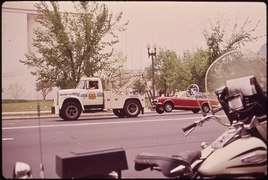 Loadstar
Loadstar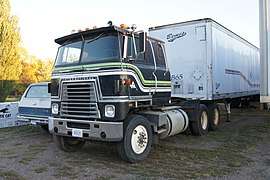 Transtar
Transtar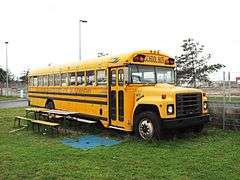 S Series Schoolmaster
S Series Schoolmaster
1980–1999
In a 1984-1986 down-sizing of the company all farm and construction machinery business, with the name "International Harvester" and the IH logo, was sold to Tenneco's J. I. Case division, at that time the company was renamed "Navistar" and a new logo, the "Diamond Road", was registered. Most S Series trucks were updated with new low-drag hoods and mechanical improvements. They became the 4000 and 8000 series. Most other models, including the S2600, stayed largely unchanged until replaced in 2000-2003.[54][55] [56][57][58]
4000 (1988–2000)
Models: 4600, 4700, 4700LP, 4800 4x4, 4900, F4900[lower-alpha 10], F4900 6x6
The 4000 series were medium duty trucks. Introduced in 1988 as an evolution of the S Series they continued in production until replaced by the "New Generation Vehicle" 4000 Series in 2001. They were normally used for local delivery and vocational work but there were also semi-tractor, service, and specialty models.[59][60]
They used an S Series cab with a new low-profile hood that improved driver visibility and reduced air resistance. Normally day-cabs were used but crew-cabs were available.[60][61]
Only International mid-range diesel engines were available. Allison, Fuller, and Spicer transmissions between 5 and 13 speeds were available. Low-profile chassis models that could have a low loading height were available. Driven front and tandem rear axles were available. Gross vehicle weight ratings (total weight of the truck) were between 21,500 pounds (9,800 kg) and 28,000 pounds (13,000 kg) and up to 56,000 pounds (25,000 kg) with tandem rear axles.[62][43]
Paystar 5000 (1972–1999)
Models: 5000, 5000 4x4, F5000[lower-alpha 10], F5000 6x6
The Paystar 5000 Series are severe service trucks. They remained largely unchanged from their introduction in 1972 until replaced by the new generation 5000 series in 1999. The 5000 had semi-tractor and specialty versions but was commonly used for straight trucks like heavy-duty dump trucks and concrete mixers.[63]
They used an aluminum day-cab also used by the Transtar/9000 conventional and had a long rectangular hood. Set-back front axle models had flat diamond-plate fenders and a butterfly hood, set-forward front axle models had a fiberglass hood. A fiberglass set-back axle fiberglass hood became available in 1994.[63]
The main change to the Paystar was the evolution of engines available. In 1980 an International mid-range engine had 210 horsepower (160 kW), Caterpillar, Cummins, and Detroit Diesel engines were available with up to 460 horsepower (340 kW) by 1999. Fuller manual transmissions with 5 to 15-speeds were available. Set-forward, set-back, and driven front axles were available and specialty models could have two steering axles. Single, tandem, and lift axles were available. Gross vehicle weight ratings (total weight of the truck) could be up to 85,000 pounds (39,000 kg) and up to 140,000 pounds (64,000 kg) including trailers.[43][64]
8000 (1987–2000)
Models: 8100, 8200, 8300 (7100 similar)
The 8000 Series were heavy-duty semi-tractors. Introduced in 1987, a short-hood model was available in 1989. The short-hood models were replaced with the new generation 8300 Series in 2002. They were used almost exclusively as a regional semi-tractor, but local semi-tractor and strait-truck models were offered.[65][66]
They used an S Series cab with a low-profile hood, a set-back front axle allowed the front fenders to be tapered and low-drag. A less aerodynamic short hood which was similar to the 4000 series was used when overall length is important. Intended for regional high-speed highway use with high fuel efficiency, there is a very wide range of aerodynamic aids for both short and long hood models. [67][68]
High-horsepower engines from Caterpillar, Cummins, Detroit Diesel, and International were available. Fuller manual transmissions were used. Gross vehicle weight ratings (total weight of the truck) were up to 50,000 pounds (23,000 kg) and up to 80,000 pounds (36,000 kg) including trailers [69]
9000i (1984–1999)
Models: 9000, 9100, 9200, 9300, 9300SBA, 9400, 9600, 9700
The 9000i Series are heavy-duty semi-tractors. They were introduced in 1984 as an update of the Transtar 4200/4300, which they replaced. The 4200/4300/9000i design remained largely unchanged from their introduction in 1970 until replaced by the new generation 9000i series in 1999. The 9000i were almost exclusively used as semi-tractors but a few straight trucks were built.[70]
They used an aluminum day-cab also used by the Paystar 5000 conventional and had a long rectangular hood. Most were set-forward front axle models but in 1989 a set-back front axle with a lower-profile hood was introduced. When used for long-distances an external "box" type sleeper could be fitted.[71]
The long hood and large grill area allowed the largest highway engines to be used. Caterpillar, Cummins, and Detroit Diesel engines were available with up to 480 horsepower (360 kW). Fuller manual transmissions with 5 to 15-speeds were available. Single and tandem, rear axles were available. Gross vehicle weight ratings (total weight of the truck) could be up to 60,000 pounds (27,000 kg) and up to 140,000 pounds (64,000 kg) including trailers.[43][72]
CO9000 (1981-1999)
Models: CO9600, CO9700
The CO9000 series was a heavy-duty cab-over-engine highway tractor. Introduced in 1981 to replace the Transtar II. A set-back model was introduced in 1988. Production ended in 1998.[73]
Making use of smaller-displacement diesel engines, the CO9670 introduced a wider cab, larger doors (shared with the conventional Transtar and Paystar), and a larger windshield. The set-back front axle version was the first cabover sold in North America with a completely flat floor.[74]
Caterpillar, Cummins, and Detroit Diesel engines were available with up to 444 horsepower (331 kW). Fuller manual transmissions with 9 to 13-speeds were available. Single and tandem rear axles were available. Gross vehicle weight ratings (total weight of the truck) could be up to 60,000 pounds (27,000 kg) and up to 140,000 pounds (64,000 kg) including trailers.[75]
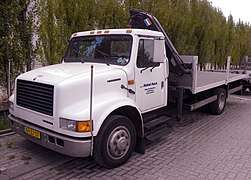 4700 Low-profile
4700 Low-profile- Paystar 5000
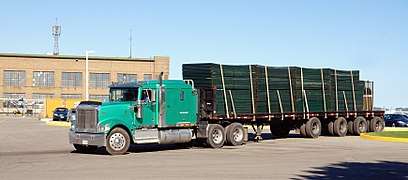 9400
9400
2000–2009
In 2001 the new "Next Generation Vehicle" models were introduced. At first most used the same series number names as the trucks they replaced, in 2006-2007 most were renamed with "Star" as the end of the name.[43][76]
In 2000 International had a range of low and medium power diesel engines, Caterpillar and Cummins engines were used in heavier applications. In 2008 two larger International engines were introduced to replace many Caterpillar and Cummins engines. All International engines between 2008 and 2014 were named "MaxxForce".[43][77]
4000 / DuraStar (2001–2017)
Models: 4300, 4400
The DuraStar series are medium-duty trucks. They were introduced in 2001 as the 4400 series and renamed DuraStar in 2008. They have the "New Generation Vehicle" (NGV) all-steel cab available as day, extended, and crew cab models. When introduced it had a complete line of International diesel engines with up to 330 horsepower (250 kW), in 2014 Cummins engines with up to 350 horsepower (260 kW) became available. Fuller 5, 6, 7, and 10-speed manual and Allison 6-speed automatic transmissions were available. Although available with tandem rear axles or as semi-tractors most have single rear axles and are used in local delivery and service. The DuraStar was replaced by the MV in 2018.[43] [78]
5000i / PayStar (2000–2016)
Models: 7300,7400, 7500, 7600
The PayStar 5000 series are severe service trucks. They were introduced in 2000 as the 5000i Series. It uses an aluminum cab also used by the 9000i. It is only available as a day-cab. It has a wide range of models with both straight and semi-tractor models. The 5000i/PayStar had a wide choice of diesel engines. International engines with up to 475 horsepower (354 kW), Caterpillar engines with up to 568 horsepower (424 kW), and Cummins engines with up to 600 horsepower (450 kW) were available. Fuller manuals and automated manuals with 10 to 18-speeds and Allison 6-speed automatic transmissions were available. Set-forward, set-back, and driven front axles were available on different models. Single, tandem, and tridem rear axles with leaf springs or air suspension were available on different models. The PayStar was replaced by the HX in 2016.[78]
7000 / WorkStar (2001–2016)
Models: 7300,7400, 7500, 7600
The WorkStar series are severe duty trucks. They were introduced in 2001 as the 7000 series and renamed WorkStar in 2008. They have the "New Generation Vehicle" (NGV) all-steel cab available as day, extended, and crew cab models. When introduced it had a complete line of International diesel engines with up to 330 horsepower (250 kW), in 2014 Cummins engines with up to 350 horsepower (260 kW) became available. Fuller manuals with 6 to 18-speeds, automated manuals with 10 to 18-speeds, and Allison 6-speed automatic transmissions were available. Set-forward, set-back, and driven front axles were available on different models. Single, tandem, and tridem rear axles with leaf springs or air suspension were available on different models. Primarily a vocational straight truck used as dump and concrete mixer trucks, semi-tractor models were also available. The WorkStar was replaced by the HX in 2016.[78]
8000 / TransStar (2002–2016)
The TranStar is a heavy duty highway semi-tractor. They were introduced in 2002 as the 8000 series and renamed TranStar in 2007. They have the "New Generation Vehicle" (NGV) all-steel cab available as day and extended cab models. A set-back front axle allowed a short low drag hood, but the short hood limited engine availability. In 2002 Caterpillar and Cummins medium-horsepower engines were used, in 2008 the new MaxxForce 11/13 engines were introduced to replace them. Fuller manuals and Allison automatic transmissions were available. Single or tandem rear axles were mounted on an air suspension. It was intended for regional use and has no high-horsepower or sleeper models.[79] [43][78]
9000i (2000–2017)
Models:9100i, 9200i, 9400i, 9900i
The 9000i is a heavy duty semi-tractor introduced in 2000. It uses an aluminum cab also used by the 5000i/PayStar and had a long rectangular hood. It is available as a day cab and with sleepers. The long hood allowed high-power engines to be used. Both set-forward and set-back front axles were available. Caterpillar engines with up to 550 horsepower (410 kW) were available until 2009 and Cummins engines with up to 600 horsepower (450 kW) were available until the end of production. Fuller manual and automated manual transmissions with 10 to 18-speeds were available. It was available with a day-cab for local and regional use and with sleepers for long-haul work.[27][43][78]
ProStar (2006–2016)
The ProStar is a heavy duty highway semi-tractor introduced in 2006. They use the NGV cab introduced in 2001 available as a day cab and with different fairings and sleepers. A set-back front axle allowed a low drag hood. The ProStar had two diesel engines, the International N13 up to 475 horsepower (354 kW) and the Cummins ISX with up to 550 horsepower (410 kW). Fuller manuals and automated manuals with 10 to 18-speeds and Allison 10-speed automatic transmissions were available. Single or tandem rear axles are mounted on an air suspension. It is intended for long-distance use and has high-horsepower and sleeper models. The ProStar was replaced by the LT in 2017.[27][43][78]
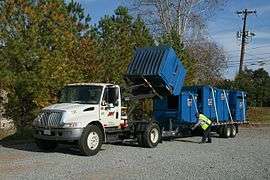 4300
4300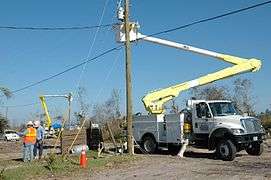 7400
7400- ProStar
2010-present
International's technology to meet 2010 emissions standards was a failure, they still couldn't meet the standards in 2012 and engine reliability suffered. Medium power Cummins engines were re-introduced in 2014. In 2018 International stopped building all engines except the medium/high-horsepower A26, all other models have Cummins engines.[43][80][81][82][83][84]
Between 2016 and 2018 all models were updated with small cosmetic and mechanical changes and renamed without "Star". Some weights on comparable models were increased but the entire range was largely unchanged.[43][78]
HX Series (2016– )
Models: 515, 520, 615, 620
The HX Series are severe duty trucks introduced in 2016 to replace the PayStar. The HX uses the same aluminum cab that the PayStar used. Set-forward and set-back front axles were available. Tandem and tridem rear axles with leaf springs or air suspension were available. It has a wide range of models with both straight and semi-tractor models. Unlike the earlier PayStar neither driven front or single rear axles were offered.[78][85]
HV Series (2017– )
Models: 507, 513, 607, 613
The HV Series are severe duty trucks introduced in 2017 to replace the WorkStar. They use the NGV cab introduced in 2001 with cosmetic changes. A spotting feature compared with the earlier WorkStar is the door window, which is one piece (the WorkStar has two-piece windows). Set-forward, set-back, and driven front axles were available. Single, tandem, and tridem rear axles with leaf springs or air suspension were available. Primarily a vocational straight truck it is often used as dump and concrete mixer trucks.[78][86]
LT Series (2017– )
The LT Series are heavy duty semi-tractors introduced in 2017 to replace the ProStar. They use the NGV cab introduced in 2001 with cosmetic changes. A spotting feature compared with the earlier ProStar is the door window, which is one piece (the ProStar has two-piece windows). It is available as a day cab and with different fairings and sleepers. A set-back front axle allowed a low drag hood. Single or tandem rear axles are mounted on an air suspension. Mechanically similar to the RH Series they have a longer hood with room for a larger engine and are meant for longer trips.[78]
RH Series (2017– )
The RH Series are heavy duty semi-tractors introduced in 2017 to replace the TranStar. They use the NGV cab introduced in 2001 with cosmetic changes. A spotting feature compared with the earlier TranStar is the door window, which is one piece (the ProStar has two-piece windows). It is available as a day cab and with different fairings and sleepers. A set-back front axle allowed a low drag hood. Single or tandem rear axles are mounted on an air suspension.[78]
MV Series (2018–)
The MV series are medium-duty trucks introduced in 2018 to replace the DuraStar. They use the NGV cab introduced in 2002 with cosmetic changes. A spotting feature compared with the earlier DuraStar is the door window, which is one piece (the DuraStar has two-piece windows). It is available available in day, extended, and crew cab models. Single or tandem axles are mounted on either spring or air suspension. Dimensions are the same as the DuraStar but the MV has a slightly wider range of GVWRs. Although available with tandem rear axles most have single rear axles and are used in local delivery and service. All trucks have Cummins engines and Eaton Fuller or Allison transmissions. Rear air suspension is offered on both single and tandem rear axles.[78][87][88]
Notes
- 1 2 3 4 5 6 7 8 9 Rating is approximate, body and optional equipment used affect actual payload.
- 1 2 3 4 5 This model (also known as "forward control") has the cab and driver in front of the wheels and has a flat front.
- ↑ Includes all models built by Metropolition Body Co. 1938-1963
- 1 2 3 4 Light-duty trucks (up to 14,000 lb (6,400 kg))
- 1 2 3 4 5 6 7 8 9 10 11 12 13 14 15 16 17 18 19 20 21 22 23 24 Gross Vehicle Weight Rating is the loaded weight of the truck.
- 1 2 3 4 5 6 7 8 9 10 11 12 13 14 Gross Combination Weight Rating is the loaded weight of the truck and any trailers.
- 1 2 3 4 5 6 7 8 9 10 11 12 13 14 15 16 17 18 19 20 21 Number of wheels × number of powered wheels, with dual tires counted as a single wheel.
- 1 2 This model has the cab and driver above and behind the wheels and has a short hood.
- ↑ This model has the cab and driver above the wheels and has a flat front. It often has a sleeper compartment.
- 1 2 3 4 5 6 7 8 9 "F" models have tandem rear axles.
- ↑ Crismon (1995), pp. 3-4, 12-37.
- ↑ Foster (2015), pp. 6-18.
- ↑ Mroz (1996), pp. 206.
- 1 2 "Early Vehicles -- 1907-1929", Wisconsin Historical Society (2011)
- ↑ "I.H.C. Roadster Specifications", Wisconsin Historical Society (2011)
- ↑ Crismon (1995), pp. 12-25.
- ↑ Foster (2015), pp. 6-20.
- ↑ Crismon (1995), pp. 25-54.
- ↑ Foster (2015), pp. 12, 14, 18-27.
- ↑ Burness (1985), pp. 215-225.
- ↑ Crismon (1995), pp. 3-4, 12-157.
- ↑ Foster (2015), pp. 21-59.
- ↑ Mroz (1996), pp. 206-208.
- ↑ "Metro -- 1953-1963", Wisconsin Historical Society (2011)
- ↑ Staff. "History and Development of International Harvester". Wisconsin State Historical Society. Retrieved Dec 14, 2013.
- ↑ Carlson, B Mithchell (March–April 2013). "The International Harvest Metro Van". Vintage Truck.
- ↑ Crismon (1995), pp. 142-144, 157-158, 175...367.
- ↑ Foster (2015), pp. 57-61, 92-93.
- ↑ Burness (1985), pp. 226-231.
- ↑ Crismon (1995), pp. 6-8, 156-309.
- ↑ Foster (2015), pp. 60-105.
- ↑ Mroz (1996), pp. 209-210.
- ↑ "K Line", Wisconsin Historical Society (2011)
- ↑ "KB Line", Wisconsin Historical Society (2011)
- ↑ Burness (1985), pp. 226-227.
- ↑ Crismon (1995), pp. 156, 163-166, 168-170,...217-220.
- 1 2 3 Foster (2015), pp. 62-66, 71-81.
- ↑ "L Line", Wisconsin Historical Society (2011)
- ↑ Burness (1985), pp. 228.
- ↑ Crismon (1995), pp. 217-218, 222-237, 244.
- ↑ Foster (2015), pp. 82-89.
- ↑ "R Line", Wisconsin Historical Society (2011)
- ↑ "A Line", Wisconsin Historical Society (2011)
- ↑ "B Line", Wisconsin Historical Society (2011)
- ↑ Mueller, Mike (2003), Pickup Trucks, St. Paul, MN: Motorbooks International, p. 101
- ↑ Burness (1985), pp. 230-232.
- ↑ Crismon (1995), pp. 281-331.
- ↑ Burness (1985), pp. 232-248.
- ↑ Crismon (1995), pp. 9-10, 310-504.
- ↑ Foster (2015), pp. 106-157.
- ↑ Mroz (1996), pp. 21-211.
- ↑ Motor's (1973), pp. 946-948.
- 1 2 3 4 5 6 7 8 9 10 11 12 13 14 15 16 International Truck brochures
- ↑ Crismon (1995), pp. 331-332, 337-339, 342-343,...481-482.
- ↑ "Loadstar", Wisconsin Historical Society (2011)
- ↑ "Fleetstar", Wisconsin Historical Society (2011)
- ↑ Motor's (1972), pp. 919–920, 943, 946, 1066, 1224.
- 1 2 "Transtar", Wisconsin Historical Society (2011)
- ↑ Crismon (1995).
- ↑ "Cargostar", Wisconsin Historical Society (2011)
- ↑ "Paystar", Wisconsin Historical Society (2011)
- ↑ "S Series", Wisconsin Historical Society (2011)
- ↑ Crismon (1995), p. 485.
- ↑ Crismon (1995), pp. 3-4, 505-605.
- ↑ Davies (2000), p. 402.
- ↑ Foster (2015), pp. 158-183.
- ↑ Mroz (1996), pp. 211-212.
- ↑ Klein, Sarah A. (March 29, 2008). "Rust belt no more: the demise of manufacturing". Crain's Chicago Business. Retrieved August 15, 2018.
- ↑ Crismon (1995), pp. 560, 563, 572, 604-605.
- 1 2 Foster (2015), pp. 176-178.
- ↑ Crismon (1995), pp. 559-560, 565-566.
- ↑ Crismon (1995), pp. 564-565, 604-605.
- 1 2 Crismon (1995), pp. 441, 460, 597, 607.
- ↑ Crismon (1995), pp. 595, 527, 520, 538, 553, 568, 607.
- ↑ Crismon (1995), pp. 547, 566-567, 573, 579.
- ↑ Foster (2015), p. 174.
- ↑ Crismon (1995), pp. 546-547, 551, 566-567.
- ↑ Foster (2015), p. 177.
- ↑ Crismon (1995), pp. 566, 661.
- ↑ Crismon (1995), pp. 419, 529, 563, 601.
- ↑ Crismon (1995), pp. 529, 531,538, 563, 567.
- ↑ Crismon (1995), pp. 593, 600.
- ↑ Crismon (1995), pp. 511, 547.
- ↑ Crismon (1995), pp. 529, 531.
- ↑ Crismon (1995), pp. 534, 545, 568.
- ↑ Foster (2015), pp. 184-197.
- ↑ Foster (2015), pp. 190-191.
- 1 2 3 4 5 6 7 8 9 10 11 12 International Truck brochures (2018)
- ↑ Foster (2015), p. 186.
- ↑ Muller, Joan (August 2, 2012). "Death by hubris? The catastrophic decision that could bankrupt a great American manufacturer". Forbes Media. Retrieved August 15, 2018.
- ↑ Cannon, Jason (December 13, 2013). "Court sides with engine makers, against EPA and throws out rule that benefitted Navistar". Overdrive Magazine. Retrieved August 15, 2018.
- ↑ Jaillet, James (July 11, 2014). "Class-action lawsuit accuses Navistar of knowingly selling defective engines". Overdrive Magizine. Retrieved August 15, 2018.
- ↑ Lockridge, Deborah (August 14, 2017). "Navistar Hit With $30.8 Million Judgment in ProStar/MaxxForce Lawsuit". Heavy Duty Trucking/Truckinginfo. Retrieved August 15, 2018.
- ↑ Foster (2015), pp. 190-191, 198.
- ↑ Berg, Tom (Feb 2, 2016), "International HX Series of Class 8 Vocational Trucks", Construction Equipment, retrieved Sep 18, 2018
- ↑ "International HV Class 8 Trucks", Construction Equipment, Sep 27, 2017, retrieved Sep 18, 2018
- ↑ Hawes, Clarissa (Mar 7, 2018), "Navistar Caps Resurgence With New International MV Work Truck", Trucks.com, retrieved Sep 18, 2018
- ↑ Skydel, Seth (Apr 2018), "Product refresh: Internationas Trucks launches its new medium-duty MV Series", Fleet Equipment, retrieved Sep 18, 2018
References
- Burness, Tad (1985). American Truck & Bus Spotter's Guide 1920-1985. Motorbooks International. ISBN 0-87938-198-1.
- Crismon, Frederick W. (1995). International Trucks. Motorbooks International. ISBN 0-76030069-0.
- Davies, Peter J. (2000). The World Encyclopedia of Trucks. Lorenz Books. ISBN 0-7548-0518-2.
- Foster, Patrick (2015). International Harvester Trucks, The Complete History. Motorbooks. ISBN 978-0-7603-4860-4.
- Mroz, Albert (1996). The Illustrated Encyclopedia of American Trucks and Commercial Vehicles. Krause. ISBN 0-87341368-7.
- "International Truck Brochures". Navistar, Inc. 2018. Retrieved August 15, 2018.
- "International Truck Specifications". IHC-McCormack Collection. Wisconsin Historical Society. 2011. Retrieved Jan 24, 2018.
- "International Harvester Documents". IHC-McCormack Collection. Wisconsin Historical Society. 2011. Retrieved Jan 24, 2018.
- Motor's Truck and Diesel Repair Manual (26 ed.). Motor. 1973. ISBN 0-910992-16-9.